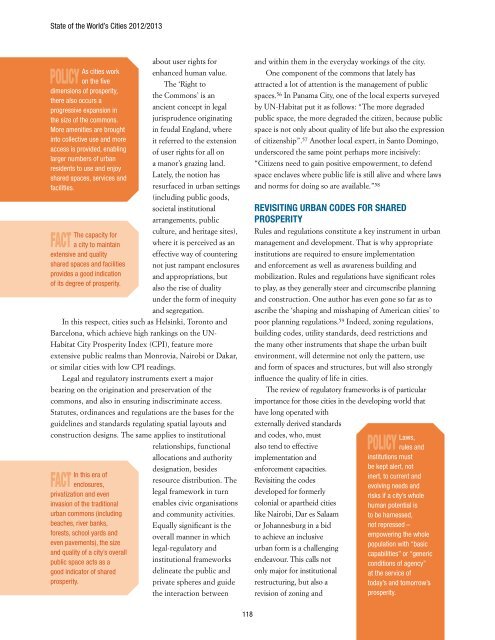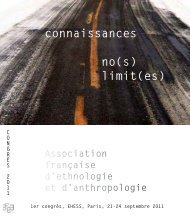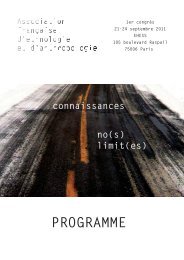Innovating to Support <strong>the</strong> Transition to <strong>the</strong> City <strong>of</strong> <strong>the</strong> 21st CenturyBox 3.2.3Individual versus collective interestsThe legal foundation <strong>of</strong> <strong>the</strong> 20th-century city lies in <strong>the</strong>ancient tenets <strong>of</strong> Roman Law and <strong>the</strong> Napoleonic Code,toge<strong>the</strong>r with <strong>the</strong> subsequent elaboration into modern civiland common law. The gist <strong>of</strong> this legal corpus is <strong>the</strong> preeminence<strong>of</strong> <strong>the</strong> individual, who is considered as possessed<strong>of</strong> inherent rights as represented in <strong>the</strong> 18th century FrenchRevolution’s Declaration <strong>of</strong> <strong>the</strong> Rights <strong>of</strong> Man and <strong>the</strong> Citizen.Within this individualistic legal tradition, property rights reignsupreme, with <strong>the</strong> emphasis on <strong>the</strong> rights <strong>of</strong> owners to <strong>the</strong>detriment <strong>of</strong> <strong>the</strong>ir social implications and o<strong>the</strong>r, broader,collective interests, including duties and responsibilities. Withparticular regard to urban settings, ‘land and property areconceived largely as commodities whose economic value isdetermined by <strong>the</strong> owners’ interests.’ 52 In this system, <strong>the</strong>role <strong>of</strong> <strong>the</strong> State at all levels is relegated to harmonizing andmediating <strong>the</strong>se interests, and to oversee those assets andfacilities that require collective use.energy consumption and poor regard for <strong>the</strong> potential foragglomeration economies.Towards a New Legal-Urban Order forHolistic ProsperityDuring <strong>the</strong> last two decades, <strong>the</strong> pitfalls <strong>of</strong> <strong>the</strong> conventionalurban development model have become more glaring. Asshown in <strong>the</strong> previous section (Urban Prosperity throughPlanning and Design) <strong>the</strong> potential <strong>of</strong> <strong>cities</strong> has not beenfully harnessed, a more common trend has developed whereurban development tends to be spatially fragmented and <strong>the</strong>benefits <strong>of</strong> prosperity remains socially segmented.In contrast, over <strong>the</strong> past two decades some Brazilian<strong>cities</strong> have taken to re-examining <strong>the</strong> prevailing urbanlegal order, with bold practical schemes inspired by a set<strong>of</strong> alternative, radical urban doctrines and jurisprudencewhich depart from <strong>the</strong> classical liberal legalism exaltingindividualism and private property. After a long period<strong>of</strong> consultations andnegotiations, a nationwidethose fewCity Statute was adoptedfact <strong>cities</strong> featuring in 2001 enshrining a Rightbalanced andto <strong>the</strong> City. The Statutesustainable prosperitymakes an importanthave effectivelycontribution to urbandeployed adequatelaws, regulations and law, facilitating sharedinstitutions in support <strong>of</strong> prosperity, particularly<strong>the</strong>ir transformation. in <strong>the</strong> context <strong>of</strong> afactAlthough <strong>the</strong> 20th-century city tends to exhibit fairdegrees <strong>of</strong> vibrancy and dynamism, whatever attendantprosperity it experiences is <strong>of</strong>ten skewed and unsustainable – and<strong>the</strong>refore ridden with perennial crises.developing country. The Statute also “broke with <strong>the</strong>long-standing tradition <strong>of</strong> civil law and set <strong>the</strong> basis <strong>of</strong>a new legal-political paradigm for urban land use anddevelopment control.” 53 A prominent scholar highlightsfour dimensions <strong>of</strong> Brazil’s 2001 City Statute: “Aconceptual one, providing elements for <strong>the</strong> interpretation<strong>of</strong> <strong>the</strong> constitutional principle <strong>of</strong> <strong>the</strong> social functions <strong>of</strong>urban property and <strong>of</strong> <strong>the</strong> city; <strong>the</strong> regulation <strong>of</strong> newinstruments for <strong>the</strong> construction <strong>of</strong> a different urban orderby <strong>the</strong> municipalities; <strong>the</strong> indication <strong>of</strong> processes for <strong>the</strong>democratic management <strong>of</strong> <strong>cities</strong>; and <strong>the</strong> identification<strong>of</strong> legal instruments for <strong>the</strong> comprehensive regularisation<strong>of</strong> informal settlements in private and public urbanareas.” 54 This new urban legal order has had highlyvisible effects. As a nation and at macro-economic level,Brazil is among a handful <strong>of</strong> countries in <strong>the</strong> world thathas been able to achieve remarkable growth rates formuch <strong>of</strong> <strong>the</strong> early years <strong>of</strong> this century, despite <strong>the</strong> globaleconomic turbulence. More significantly, Brazilian <strong>cities</strong>have been able to expand <strong>the</strong> middle class segments <strong>of</strong><strong>the</strong>ir populations and to improve economic and livingconditions for substantial numbers <strong>of</strong> poor residents.Although still very high, <strong>cities</strong> are reducing incomeinequalities, as measured by <strong>the</strong> Gini coefficient, whichdecreased from 0.606 in 1990 to 0.569 in 2009. 55Revitalized ‘Rights to <strong>the</strong> Commons’ andExpansion <strong>of</strong> <strong>the</strong> Public Realm‘Commons’ reinforce <strong>the</strong> social function <strong>of</strong> property andthat <strong>of</strong> <strong>the</strong> city as a whole, while recognizing <strong>the</strong> dynamism<strong>of</strong> private assets. Laws, regulations and institutions asfactors <strong>of</strong> restraint, opportunity and action, act as <strong>the</strong> leversthat can optimize <strong>the</strong> socialfunction <strong>of</strong> property andbalance it out with privateShared urbanpolicy prosperityrights and assets. It mustis about enhancing <strong>the</strong>be stressed here that thispublic realm, equitablesocial function is not about sharing <strong>of</strong> public goods andownership rights or <strong>the</strong>irconsolidating rights to <strong>the</strong>transactional implications. commons for all.Ra<strong>the</strong>r, it is essentially117
State <strong>of</strong> <strong>the</strong> World’s Cities <strong>2012</strong>/<strong>2013</strong>about user rights forAs <strong>cities</strong> work enhanced human value.policy on <strong>the</strong> fiveThe ‘Right todimensions <strong>of</strong> prosperity,<strong>the</strong> Commons’ is an<strong>the</strong>re also occurs aprogressive expansion inancient concept in legal<strong>the</strong> size <strong>of</strong> <strong>the</strong> commons. jurisprudence originatingMore amenities are brought in feudal England, whereinto collective use and more it referred to <strong>the</strong> extensionaccess is provided, enabling <strong>of</strong> user rights for all onlarger numbers <strong>of</strong> urbana manor’s grazing land.residents to use and enjoyshared spaces, services andLately, <strong>the</strong> notion hasfacilities.resurfaced in urban settings(including public goods,societal institutionalarrangements, publicculture, and heritage sites),The capacity forfact a city to maintain where it is perceived as anextensive and qualityeffective way <strong>of</strong> counteringshared spaces and facilities not just rampant enclosuresprovides a good indication and appropriations, but<strong>of</strong> its degree <strong>of</strong> prosperity.also <strong>the</strong> rise <strong>of</strong> dualityunder <strong>the</strong> form <strong>of</strong> inequityand segregation.In this respect, <strong>cities</strong> such as Helsinki, Toronto andBarcelona, which achieve high rankings on <strong>the</strong> UN-Habitat City Prosperity Index (CPI), feature moreextensive public realms than Monrovia, Nairobi or Dakar,or similar <strong>cities</strong> with low CPI readings.Legal and regulatory instruments exert a majorbearing on <strong>the</strong> origination and preservation <strong>of</strong> <strong>the</strong>commons, and also in ensuring indiscriminate access.Statutes, ordinances and regulations are <strong>the</strong> bases for <strong>the</strong>guidelines and standards regulating spatial layouts andconstruction designs. The same applies to institutionalrelationships, functionalallocations and authoritydesignation, besidesIn this era <strong>of</strong>resource distribution. Thefact enclosures,privatization and evenlegal framework in turninvasion <strong>of</strong> <strong>the</strong> traditional enables civic organisationsurban commons (including and community activities.beaches, river banks,Equally significant is <strong>the</strong>forests, school yards andoverall manner in whicheven pavements), <strong>the</strong> sizelegal-regulatory andand quality <strong>of</strong> a city’s overallpublic space acts as ainstitutional frameworksgood indicator <strong>of</strong> shared delineate <strong>the</strong> public andprosperity.private spheres and guide<strong>the</strong> interaction betweenand within <strong>the</strong>m in <strong>the</strong> everyday workings <strong>of</strong> <strong>the</strong> city.One component <strong>of</strong> <strong>the</strong> commons that lately hasattracted a lot <strong>of</strong> attention is <strong>the</strong> management <strong>of</strong> publicspaces. 56 In Panama City, one <strong>of</strong> <strong>the</strong> local experts surveyedby UN-Habitat put it as follows: “The more degradedpublic space, <strong>the</strong> more degraded <strong>the</strong> citizen, because publicspace is not only about quality <strong>of</strong> life but also <strong>the</strong> expression<strong>of</strong> citizenship”. 57 Ano<strong>the</strong>r local expert, in Santo Domingo,underscored <strong>the</strong> same point perhaps more incisively:“Citizens need to gain positive empowerment, to defendspace enclaves where public life is still alive and where lawsand norms for doing so are available.” 58Revisiting Urban Codes for sharedProsperityRules and regulations constitute a key instrument in urbanmanagement and development. That is why appropriateinstitutions are required to ensure implementationand enforcement as well as awareness building andmobilization. Rules and regulations have significant rolesto play, as <strong>the</strong>y generally steer and circumscribe planningand construction. One author has even gone so far as toascribe <strong>the</strong> ‘shaping and misshaping <strong>of</strong> American <strong>cities</strong>’ topoor planning regulations. 59 Indeed, zoning regulations,building codes, utility standards, deed restrictions and<strong>the</strong> many o<strong>the</strong>r instruments that shape <strong>the</strong> urban builtenvironment, will determine not only <strong>the</strong> pattern, useand form <strong>of</strong> spaces and structures, but will also stronglyinfluence <strong>the</strong> quality <strong>of</strong> life in <strong>cities</strong>.The review <strong>of</strong> regulatory frameworks is <strong>of</strong> particularimportance for those <strong>cities</strong> in <strong>the</strong> developing world thathave long operated wi<strong>the</strong>xternally derived standardsand codes, who, mustalso tend to effective policy Laws,rules andimplementation andinstitutions mustenforcement capa<strong>cities</strong>.be kept alert, notinert, to current andRevisiting <strong>the</strong> codesevolving needs anddeveloped for formerlyrisks if a city’s wholecolonial or apar<strong>the</strong>id <strong>cities</strong> human potential islike Nairobi, Dar es Salaam to be harnessed,or Johannesburg in a bidnot repressed –to achieve an inclusiveempowering <strong>the</strong> wholepopulation with “basicurban form is a challengingcapabilities” or “genericendeavour. This calls notconditions <strong>of</strong> agency”only major for institutional at <strong>the</strong> service <strong>of</strong>restructuring, but also atoday’s and tomorrow’srevision <strong>of</strong> zoning andprosperity.118





